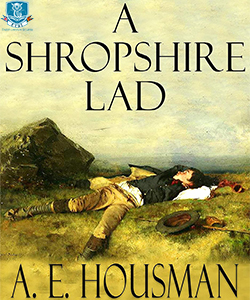Farewell to Barn and Stack and Tree
“Farewell to barn and stack and tree,
Farewell to Severn shore.
Terence, look your last at me,
For I come home no more.”
“The sun burns on the half-mown hill,
By now the blood is dried;
And Maurice amongst the hay lies still
And my knife is in his side.”
“My mother thinks us long away;
‘Tis time the field were mown.
She had two sons at rising day,
To-night she’ll be alone.”
“And here’s a bloody hand to shake,
And oh, man, here’s good-bye;
We’ll sweat no more on scythe and rake,
My bloody hands and I.”
“I wish you strength to bring you pride,
And a love to keep you clean,
And I wish you luck, come Lammastide,
At racing on the green.”
“Long for me the rick will wait,
And long will wait the fold,
And long will stand the empty plate,
And dinner will be cold.”
A Shropshire Lad

“A Shropshire Lad,” penned by A.E. Housman, stands as a seminal work within the realm of Victorian poetry. First published in 1896, this collection of sixty-three lyric poems encapsulates the poet’s profound exploration of themes such as fleeting youth, unrequited love, and the inexorable nature of mortality. Housman’s verses are deeply rooted in the rural landscape of Shropshire, where the poet draws inspiration from the picturesque surroundings of the English countryside. This poetic masterpiece not only captivates readers with its evocative imagery and melodic language but also delves into the complexities of the human experience, weaving together a tapestry of emotions that resonates across generations. As we embark on an exploration of ‘A Shropshire Lad,’ we find ourselves immersed in the poignant reflections of a poet whose words continue to echo with timeless resonance, inviting us to contemplate the transient nature of life and the enduring power of poetic expression.
Stanza One
Line One
“Farewell to barn and stack and tree,
- Farewell means good bye.
- The narrator bids farewell to three inanimate objects. Note negativity associated with the numerological symbol of number three.
- It is questionable why the narrator bids farewell to inanimate objects, but not to the people associated with them. It figuratively reveals how he cuts himself off from the rest of the human civilization.
- The statement further depicts the connection of the speaker to his familiar surrounding.
- The phrase, “barn and stack and tree” is an enumeration. Since the listing is done using coordinating conjunctions, it can be classified as a syndeton too.
Line Two
Farewell to Severn shore.
- The narrator continues to say good bye to inanimate objects. This time he says it to “Severn shore,” the land bordering the river Severn in England.
- The name of the river adds a specific geographical setting to the poem.
- The repetition of the first word “farewell” in consecutive lines can be identified as an anaphora. It adds emphasis to the deeper emotions associated with the departure of the speaker.
Line Three
Terence, look your last at me,
- Terence is a passer-by who happens to meet the narrator. Terence is told the tragic incident that has taken place by the speaker, which is re-told in direct speech to the reader.
- The comma (,) in the middle that disturbs the flow of the line is called a caesura. The brief pause it adds effectively mixes a solemnly melancholic tone to the poem.
- We usually say, “look at me for the last time.” However the the regular syntax is inverted by the narrator. The technique is classified as an anastrophe.
- In the usual syntax, the emphasis is added to “time,” whereas in the version spoken by the speaker adds emphasis to “me.”
Line Four
For I come home no more.
- For is a synonym for because.
- The diction of the speaker is peculiar and it adds pathos to the overall tone. Note the assonance of “O” sounds produced when the words are enunciated. It makes the poem mournful.
- The repetition of the ending consonants in “come,” and “home” is a consonance.
Book of Genesis

Cain and Abel were the two sons of Adam and Eve, the first human beings, according to the biblical narrative. Abel was a shepherd, and Cain was a farmer. Both brothers brought offerings to God, but God favoured Abel’s offering of the best of his flock. In contrast, God did not favour Cain’s offering of the fruits of the ground.
Feeling jealous and angry, Cain lured Abel into a field and killed him out of resentment. God confronted Cain about his actions, asking him about Abel’s whereabouts. In response, Cain famously replied, “Am I my brother’s keeper?” God then pronounced a curse on Cain for murdering his brother, making him a wanderer on earth, and placing a mark on him to protect him from harm.
The story of Cain and Abel serves as a cautionary tale about the consequences of envy, disobedience, and violence. It illustrates themes of sin, guilt, and the importance of moral responsibility.
Why Genesis?
In an alternative reading, the story of the fratricide is an allusion to the story of Abel and Cain. Maurice, the diseased brother, the pastoral setting, the love that divides the two brothers, and the wandering off of the murderer are all parallels to the story of Cain and Abel. Even though the Book of Genesis provides an omniscient third-person point of view that is not entirely transparent, the poem presents the first-hand experience of the one who is guilty of killing his brother. While the biblical version abruptly vilifies the accused, Housman provides an emotional and poignant account of the confession of the convict.
Stanza Two
Line One
“The sun burns on the half-mown hill,”
- The line figuratively describes the time. The burning sun on the hill is a creative way to say its after noon.
- The sun is personified in the line as it performs the action of burning.
- “half-mown” is a neologism. It indicates an incomplete action that symbolises the incomplete lives of both the convict and the victim.
Line Two
“By now the blood is dried;”
- “blood” is a symbol that reveals upcoming tragedy.
- Even though it is evident that an accident has happened, the dried blood does not immediately indicate any sign of a murder.
- The euphemistic opening of the confession indicates the hesitation of the speaker to reveal what happened.
Line Three
“And Maurice amongst the hay lies still”
- The coordination conjunction reveals that the blood is connected to Maurice.
- Amongst is a dated synonym for the preposition, among
- Maurice is dead, but the narrator does not directly reveal it. The literary device here is called ‘euphemism.’
- Note the similarity between Maurice and hay. Both are not alive and were cut and stabbed.
- The word order of the line is inverted. The common syntax should be “And Maurice lies still amongst hay.” However, the narrator brings the motionlessness of Maurice to the end of the line, adding emphasis to it.
Line Four
“And my knife is in his side.”
- The speaker euphemistically says that he has stabbed Maurice to death.
- The coordinating conjunction repeats in the consecutive lines, producing an anaphora. It adds emphasis to the emotional trauma of the speaker.
- The possessive pronoun immediately makes the speaker responsible for the murder of Maurice.
Stanza Three
Line One
“My mother thinks us long away;”
- Mother is the fourth character in the poem. (Maurice, his brother who killed him, Terence, to whom the story is told, and the mother)
- This line reveals for the 1st time that the speaker and Maurice are brothers because their mother is the same. This is why we earlier introduced the murder as a fratricide.
- The mother can be identified as a victim as she will have to face the society in the absence of her two sons.
- Note that there is no mention of a father in the poem. (check alternative readings for more interpretations)
Line Two
“‘Tis time the field were mown.”
- ‘Tis, is an apheresis; which is a version of an elision where a syllable is removed from the beginning of a word.
- Time and the transience associated with it are themes present in the overall poem.
- The field is singular, and the verb associated with it is plural. This grammatical construction is called the subjunctive mood. It is used to indicate hypothetical ideas that are not achievable in the immediate present.
Line Three/Four
She had two sons at rising day,
To-night she’ll be alone.”
- “she” is a reference to the mother.
- The simple past tense indicates that the mother has lost both her sons because one is murdered and the other is fleeing.
- “rising day” is another way to say morning. The use of circumlocutory language can be identified as a periphrasis.
- The final line highlights the isolation of the mother as a result of the actions of her children.
Stanza Four
Line One
“And here’s a bloody hand to shake,”
- The coordinating conjunction connects the stanza to the previous one. Thus, it further explains the isolation of the mother, which is connected to the departure of the speaker.
- The speaker extends his hand towards Terence to bid farewell to him. Note that he never left, even though he had already said good-bye several times. The speaker’s hesitation to leave further sheds light on his attachment to the surrounding.
- Shaking hands is a spontaneous greeting, and one does not announce it prior to the action. This indicates the broken esteem of the speaker and his fear of being rejected by others—in this case, by Terence.
- “bloody hands” refers to hands that are covered by blood. His awareness of the blood in his hands figuratively reveals his acknowledgement of his sin.
- “hand” functions as a synecdoche in the line. A part of the speaker’s body is introduced separately, as he does not prefer to call it his own. Therefore, his repulsive attitude figuratively reveals that the murder is a reflex, a sudden and involuntary response to stimuli.
Line Two
“And oh, man, here’s good-bye;”
- The repetition of the coordinating conjunction “And” functions as an anaphora, and it continues to indicate the emotional trauma of the narrator.
- “oh” is an interjection that contributes to enhance the woe of the narrator.
- Note the commas that continue to disturb the reading pace; the technique is called caesura and it is used to indicate the dejection of the speaker.
- He keeps saying good-bye and does not seem to actually go anywhere. It is a clear indication of his hesitation as well as his sadness to leave what he loves.
Line Three
“We’ll sweat no more on scythe and rake,”
- The pronoun “We” refers to the narrator and Maurice. The line further indicates the remorse of the former.
- “sweat” figuratively refers to work.
- Note the diction and syntax that contribute to produce an assonance of “o” sounds. The repetitive “o” sounds throughout the entire poem indicate the sadness of the narrator.
- “scythe” functions as a symbol of death.
Line Four
“My bloody hands and I.”
- Bloody hands refer to hands covered by blood. The blood on his hands continues to remind the reader of the sin committed by the narrator.
- The narrator’s awareness of his wrongdoing indicates guilt and regret.
- A synecdoche is used as the hands of the narrator are separated from him. This again reminds the reader that the murder is not a premeditated crime but a reflexive response.
